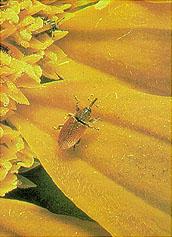Category: NOLI
Minimum Life Cycle: One year.
Distribution: Areas with sunflower farming, especially the Dakotas. Not injurious to stored grain. Two species: red and gray sunflower weevil.
Biology:
Eggs - Deposited in immature sunflower seeds in late summer.
Larvae - Develop inside sunflower seeds. Infested seeds are often harvested. Larvae drop from the infested heads and pupate in the soil.
Adults - Emerge the next summer and feed on foliage and pollen. Do not reinfest stored products.

Red and Gray Sunflower Weevil (Smicronyx fulus and S. Sordiadus). The red sunflower seed weevil adults are reddish brown, and the gray sunflower seed weevil are slightly larger and gray in color. The larvae of both species are small, cream colored, legless, and C-shaped in appearance. Seed weevil adults emerge in mid summer and feed on sunflower buds. As the sunflower matures, the adults feed on pollen, and, as the seeds mature, eggs are deposited within the seed. After developing in the seed, the larvae drop to the ground, overwintering in the soil. The insect is univoltine in North Dakota, cannot survive in storage, and is not a stored product pest (Figure 25).
(Slide courtesy of D. K McBride, and top caption courtesy North Dakota Coop. Ext. Service.)